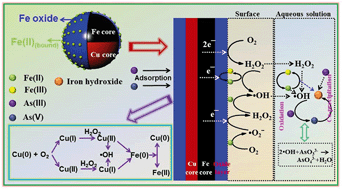Cu-Doped Fe@Fe2O3 core–shell nanoparticle shifted oxygen reduction pathway for high-efficiency arsenic removal in smelting wastewater†
Abstract
Studies on the removal of As(III) by Fe-based materials have been carried out for decades, but the time-consuming process and low removal capacity are obstacles for large-scale practical applications. Here, a rapid and efficient technique was proposed for the removal of As(III) using Cu-doped Fe@Fe2O3 core–shell nanoparticles (CFF) synthesized by a facile two-step reduction method and aging process, which realized a thorough removal of As(III) from smelting wastewater at neutral pH within 30 min. The copper doped in CFF not only provided two extra oxygen reduction pathways to enhance the molecular oxygen activation, but also improved the electron transfer ability and removal efficiency of As(III). The existence of copper contributed to the rapid oxidization and adsorption of As(III), and the removal rate increased nearly 10-times in the aerobic system. Meanwhile, the proposed Cu-doped Fe@Fe2O3 core–shell nanoparticles and shifted oxygen reduction pathway could be easily scaled up for other transition metals, such as Ni. Molecular dynamics (MD) simulations based on the large-scale atomic/molecular massively parallel simulator (LAMMPS) were also employed to investigate the formation process of CFF. Furthermore, the removal efficiency of arsenic in smelting wastewater remained to be 90% after 6 times of cycling. Therefore, the distinctive oxidation activities of CFF hold great promise for applications in arsenic removal.



 Please wait while we load your content...
Please wait while we load your content...